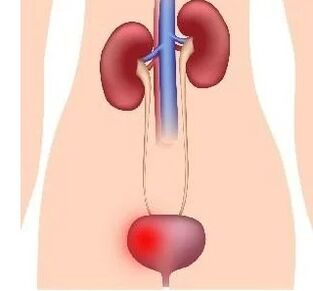cyst- This is a pathology, characterized by the development of an inflammatory process affecting the bladder wall as a result of the effects of bacterial microorganisms.

Statistical cystitis- one of the most common urological pathologies. Women are much more predisposed to the emergence of this inflammation, due to their morphophysiological traits.
Bacterial agents entering the bladder cavity are possible in three ways:
The most common causative agent of the inflammatory bladder process is E. coli (in 4 of 5 cases, which is associated with the aforementioned anatomical and morphological characteristics and the presence of this microflora in the gut).
Less often, cystitis is associated with staphylococcal, streptococcal and enterococcal microorganisms. Gram -negative sticks cause inflammation of the bladder due to instrumental and surgical interventions.
Recently, the incidence of cystitis associated with fungal microorganisms, the simplest and viruses have increased.
Only the introduction of infectious microorganisms is not enough for the development of a complete inflammatory response to the bladder because the body contains mechanisms of resistance to the action of pathogenic flora.
Cystitis development factors
Thus, in addition to the etiological factor, factors such as ::

The first symptomatic manifestations of cystitis in women
Acute cystitis clinic in a woman is characterized by a sudden onset and a pronounced-complex symptomBy:
Linking sudden symptoms and prior hypothermia of the woman's body that has appeared. Acute inflammation phenomena can sometimes be observed for 2-3 days and disappear independently without the use of therapy.

However, most often this process lasts more than 6 days, sometimes up to 15 days. The presence of a disease at a later date, depending on the appointment of therapy, requires the appointment of additional methods of examination in order to identify the associated pathologies of the body.
Characterization of pain with cystitis in women
In patients with acute cystitis, a different degree of severity of pain syndrome is observed:
The presence of blood cells and blood in the urine with cystitis (hematuria syndrome)
When an inflammatory process takes place on the bladder wall, it affects the areas of the clothes near the urethra and the emergence of the urethra. The tissue becomes loose and bleeding.
This is manifested by the appearance of micro- and macrohematuria (or blood) in the urine, which is often observed at the end of the urination law (terminal hematuria).
One of the most severe forms of acute cystitis is hemorrhagic. This type of inflammation occurs with a significant penetration of red blood cells (red blood cells) from the blood flow of the nutritional arteries to the bladder cavity.
This option is possible in the event of an increase in the permeability of the blood vessel walls (condition for anemia, vitamin deficiency, disorders in the functioning of the blood system) or damage to the above walls with bacterial cells (usually streptococcal flora). Red blood cells that have fallen into the urine of the bubble cavity in the blood stone.
When hematuria occurs, the doctor is obliged to carefully perform differential diagnosis between acute cystitis and complicated acute form - hemorrhagic cystitis. For this, additional methods of examination are determined, the type of lesion is clarified and the most accurate therapy scheme is selected.
Characteristics of acute and chronic cystitis in women
Cystitis sharp
By summarizing the above information, the sharp onset of the disease and the presence of a certain complex of symptoms for acute cystitis can be distinguished:
With a real and timely diagnosis, the pathological condition is cured within 6-10 days. In the absence of improvements after the 15th day of the course of the disease, it is worth thinking about the chronicing of inflammatory changes.

In addition to the hemorrhage, there are two other forms of the complicated course of acute cystitis:
The duration of the course of pathology in the case of the development of complicated forms increases significantly.
There is another form of cystitis - interstitial.It is characterized by inflammation of all membranes of urine bubbles. The clinic is dominated by rapid rapid urination, reaching up to 180 times a day, active complaints of severe pain in the hypogastric region when filling the bladder and its regression after the act of urination. The bubble capacity is significantly reduced, as a result of which the above symptoms appear.
Chronic cystitis
Chronic cystitis, in contrast to acute, rarely occurs as a primary pathology and in most cases is a secondary complication of the flow of existing bladder, kidney, urethra.
Given this fact, it is necessary to carefully examine the body for the presence of the above pathological changes, as well as to exclude or confirm the specific origin of the microorganisms - the tuberculosis stick, the occupation of Trichomonas.
Clinically, chronic cystitis manifests either from a continuous course with moderate changes in complaints and clinical urine analysis, or in the form of a repeated pathology with periods of irritation (similar to the acute cystitis clinic) and complete regression (with a lack of manifestation of the pathological process).
Thus, the objective manifestations of the chronic cystitis correspond to such in the acute process. They relate to the usual protective properties of the body, the etiology of a bacterial agent that caused an infectious process and the degree of severity of inflammation. Pain, frequent urination, itching, blood and cloud urine are less pronounced with continuous course and correspond to the acute process with the repeated flow of chronic cystitis.
Due to the lesion of the inflammatory reaction of the mucosa, the edema of all layers of the urinated wall and the increase in intrapacear pressure created all the conditions for the formation of vesicular-memorial reflux, d. m. Th. the casting fluid from the bladder again in the ureter (connects the kidneys and bubbles).

The doctor-urologist is engaged in verifying the diagnosis and the purpose of cystitis therapy.
To accurately diagnose inflammatory pathology, it is necessary to clearly fix patients' complaints and its history (which preceded the development of pathology).
Clinical manifestations are quite specific and can immediately indicate the presence of this disease, however, it is necessary to carefully perform differential diagnosis between all types of cystitis, as well as other bladder pathologies and abdominal diseases.
From anamnesis, data on the stresses and impacts of low temperatures, medicines taken, as well as other lesions located in the pelvic organs and the genitourinary system, will be useful.
After clarifying complaints and an anamnesis, the clinical (general) urine analysis will be able to help verify the diagnosis - increased levels of white and red blood cells will be detected in it (red blood leukocytes and cells).
To identify the type of bacterial microorganism that caused the inflammatory process, the urine is planting in specific nutritional media, which can be used in the future to choose the most effective antibacterial drug.
Before the urine fence for bacteriological examination, it is necessary to qualitatively treat the field of the external genitals with an antiseptic solution. Performing cystoscopy in the presence of acute inflammatory reaction is contraindicated.
To diagnose chronic cystitis, along with collection of complaints and data on anamnesis, cystoscopy helps during prayer. This will determine all the necessary characteristics of an inflammatory disease. With this manipulation, it is possible to obtain biopsy-mucosa material with urine bubble. Also, to identify chronic cystitis, a contrast X -Ray study is recommended.
























